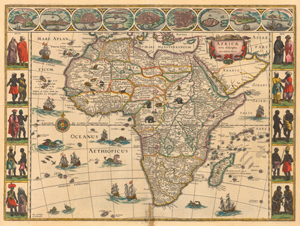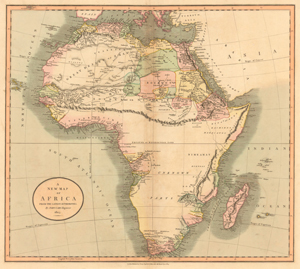As Africa was largely unexplored by Europeans for many centuries the maps that were created were by and large grossly inaccurate. They are still a fascinating look into the past. Mountain ranges that did not exist, countries that are fables and, the incognita that is unknown litter these maps. For Europeans Africa could be seen as the unknown, the unfathomable and ultimately the conquerable.
| Map | Description |
|---|---|
 1554 | The earliest obtainable map of the whole continent of Africa. Because it was issued with some variations in both of Münster's very popular works, Geographia (1540-1552) and Cosmographia (1544-1628), Münster's map is difficult to date precisely. Münster's was a professor of Hebrew at Heidelberg and then at Basel, where he settled in 1529 and later died of the plague. By soliciting descriptions and maps from German scholars and foreigners, he was able over time to include up-to-date information in the various editions of his atlases, becoming the most influential cartographer of the mid-16th century. Münster's was the first mapmaker to print separate maps of the four then known continents (Europe, Africa, Asia, America). |
 1584 | The standard map of Africa for the last quarter of the sixteenth century. Ortelius lived and died in Antwerp, where he had a bookselling business. He traveled to many of the great book fairs, established contacts with literati in many countries, collected maps, and became an authority on historical cartography. In 1570, he published the Theatrum, an atlas of fifty-three maps, the first collection of uniform-sized maps depicting all the countries of the known world””the first real atlas. Each map had text on the back describing the country depicted and listing Ortelius’s sources of information. The atlas was phenomenally successful and revered, printed in many editions in seven languages for more than forty years (1570-1612), with an ever increasing number of maps. |
 1644 | One of the most decorative and popular of all early maps of Africa, from the “golden age” of Dutch mapmaking. First issued in 1630, the map was reprinted many times between 1631 and 1667, appearing in Latin, French, German, Dutch, and Spanish editions of Blaeu’s atlases. The maps and atlases of the Blaeu family business, carried on after Willem’s death by sons Cornelis and Joan, marked the epitome of fine engraving and coloring, elaborate cartouches and pictorial detail, and fine calligraphy””the most magnificent work of its type ever produced. |
 1710 | A large decorative map by a German-born English mapmaker known for a number of influential maps, including the “Beaver Map” of North America. The dedicatee, Charles Mordaunt (1658-1735), was a nobleman and military leader, commander of the English campaign in Spain in 1705. One of the characteristics of a Moll map is the textual chattiness. Here, for example, above Guinea, he writes: “I am credibly informed, that ye Country about hundred Leagues North of the Coast of Guinea, is inhabited by white Men, or at least a different kind of People from the Blacks, who wear Cloaths, and have ye use of Letters, make Silk, & that some of them keep the Christian Sabbath.” One wonders if Moll is attempting to promote the region by saying (to allay fears?) that there are (no doubt) educated, productive Christians living there. |
 1737 | Hase became a professor of mathematics at Wittenberg in 1719 and worked for the heirs of the great German cartographer Johann Baptiste Homann (“Homann Heirs” as the map publishing firm was known) beginning in the 1730s. In his map of Africa, “according to the most recent reports and observations,” Hase identifies several territories or kingdoms but not all have been accentuated by the colorist [see the dotted lines]. The central part of Africa is marked incognita; Blaeu’s two lakes have been replaced by a long, narrow one (Marawi) in the general area where future explorers will find Lake Nyasa, which is also called Lake Malawi. |
 1787 | A bare-bones school map of the geographic features of Africa as known toward the end of the eighteenth century. Abbé Clouet was a member of the Académie des Sciences of Rouen, and his map suggests what French schoolchildren might have been taught about Africa just before the French Revolution. In his less-is-more approach, he has attempted to remove fictitious and/or inaccurate elements in favor of a few known, inherited geographic facts, though even some of those are rather weak. He has also eliminated the clutter of surrounding islands. In his accompanying commentary, he presents a more open attitude towards map construction and the maker’s responsibility for weighing evidence. |
 1805 | A turn-of-the-century no-nonsense British map that clearly presents the geographical gaps that will consume the attention of explorers, the majority of them British, for the rest of the century. From his business in the Strand in London, Cary developed a reputation for creating beautifully printed, clean-looking and accurate maps that presented only the most recent geographical information. His “General Map” (1794) of the British Isles was the first to use Greenwich as the prime meridian, which is the standard observed today. (The time at this meridian is known as GMT, Greenwich Mean Time, which establishes the base time for other time zones around the world.) |
 1851 | Issued to coincide with the Great Exhibition of 1851 in London, Tallis’s atlas was regarded as a tour-de-force of the mapmaker’s art, scientific in intent but visually attractive: one of the most decorative atlases of the nineteenth century. The maps were drawn and engraved by John Rapkin, and the vignettes were created and engraved by various prominent artist-illustrators. About the continent of Africa, Martin writes in a note accompanying the map in the atlas: More than five-sixths of the region are still unknown to European geographers. . . . Of the alleged Mountains of the Moon we know nothing. Vast sandy wastes with occasional green and habitable spots characterize Africa. . . . The chief streams of which we have any definite and accredited account are the Nile, Niger, Joliba, Senegal, Gambia, Congo, Orange, Quilimane and the Haines. The Nile rises in Abyssinia and enters the Mediterranean at Rosetta. The Niger has its source in the Kong Mountains and enters the Atlantic after 1,660 miles. Charting its course has cost many British lives. . . . In the known parts of Africa alone 150 languages are spoken |
 1852 | First published in 1845, this map underwent little change in subsequent editions through 1869. An interesting contrast to the preceding English map of the same period, this French version appears subordinate to its surrounding pictorial (and political) representations. For its date, the map’s geographical detail is poor and rather limited. It has not benefited, for example, from the published route maps of French explorer René Caillié’s travels (1824-1828) to Timbuktu and beyond. |
 1856 | Andriveau-Goujon, J. “Carte générale de l’Afrique, d’après les dernières découvertes.” Steel engraved map, with some added color, 58 x 85 cm. Probably issued in Andriveau-Goujon’s Atlas classique et universel de géographie ancienne et moderne . . . (Paris, 1856). [Historic Maps Collection] |
 1880 | The quarter century gap between the dates of these two maps was probably the most productive period for African exploration in the history of the continent. The geographic gains from the expeditions of David Livingstone (southern), Sir Richard Francis Burton and John Hanning Speke (lake region), and Henry Morton Stanley (central) are evident in the later map, as is the advance of European influence in (and control of) territories, depicted by the color-coded areas. The 1856 map contains a shaded line across the north-central part of the continent, demarcating Arab countries from pays des Négres. Note also how the central lake area has developed by 1880 from one vast Lac d’Ouniamessi into separately identifiable lakes. More often spelled “Unyamuezi” or “Unyamwezi,” Ouniamessi means “land of the moon”””hence, the lake, later known as Lake Tanganyika, was thought to be in the land of the moon where the Mountains of the Moon existed. Stanley’s expedition (1887-1889) to aid the Equatorian governor Emin Pasha would encounter the Ruwenzori Mountains, located just north of the equator between Lakes Albert and Edward, the mountain group most closely associated today with the fabled Mountains of the Moon. |
This article uses material from the " Evolution of the Map of Africa"